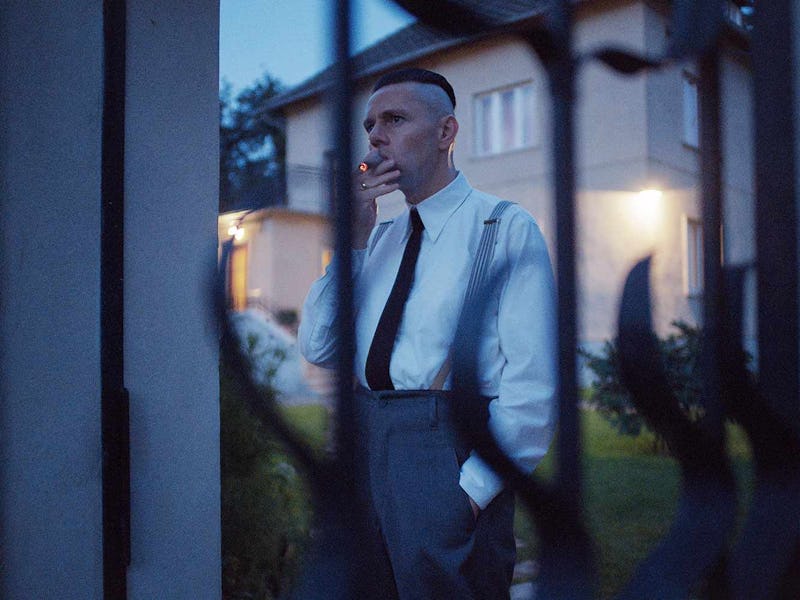The Time-Bending Ending of The Zone of Interest Reveals the Gutting Truth at Its Core
In its final moments, The Zone of Interest peers through time, and through its audience.

Warning: Spoilers for The Zone of Interest follow.
In its final scene, The Zone of Interest gives the final word on the war it’s been fighting with its Nazi protagonists.
Most of the runtime has centered on the rehearsed domestic routines of Auschwitz commandant Rudolf Höss (Christian Friedel), with sudden spurts of violent imagery invading the taut, fascistic calm of family life. We observe their movements — around a home and garden sat meters away from Auschwitz’s boundaries — in patient, fixed angles from cameras mounted at strategic points around the compound, like an evil CCTV system. Sounds from the neighboring death camp, plumes of smoke and burning incinerators creep across the horizon, and Höss and his wife, Hedwig (Sandra Hüller) lash out at unexpected moments.
In purposefully denying us images of Nazi atrocity and genocide, Glazer reveals the inner mechanisms of Nazi psychology working exactly as designed. Showing anything that happened inside Auschwitz would break the ideological reality observed by the Nazi characters: that the Holocaust was something they engineered and performed with the full extent of their barbarity, but that its architects and actors would always downplay personal responsibility for. The way they are shot and cut around show an ingrained plausible deniability, as if they’re playing to a cinematic perspective they don’t know exists.
The ferocious tension felt by the audience comes from the on-screen Nazis refusing to name and detail the genocide they are committing. But even though symbols of the Holocaust’s horror invades Höss’ domestic fortress several times throughout, it’s the film’s final moments most succinctly articulate Glazer’s thesis: that the Holocaust was committed by people who willingly desensitized themselves to their actions, not because they were meaningfully conflicted, but so they could more effectively perform them.
Auschwitz commandant Rudolf Höss’ family enjoys a life of luxury just outside the walls of the concentration camp.
In the final stretch of The Zone of Interest, Höss has left his home to meet with other commandants and leaders, where they discuss the ethnic cleansing and extermination of Hungary’s Jewish population (the mass murder of over 400,000 Hungarian Jews was named “Operation Höss”). After celebrating the Holocaust’s next stage, a drunken Höss stumbles away through a dark, echoey Nazi building. He pauses on a staircase to bend over and retch — his insides rebelling against the rigidity he’s shown throughout the film.
But it’s not just that Höss’ dry heaving shows a human body reacting to what it’s been made to do, but that he composes himself. Like the discovery of ashes in the river Höss’ children play in, like the dank tunnels Höss travels through to secretly wash himself after raping an Auschwitz prisoner, like interlude of a still red frame while a terrifying choral soundscape blasts through the speakers (if genocide victims have no physical presence, their trauma is expressed through sound), his retching is another instance of Höss being confronted with the reality of his Nazism. But like everything that’s come before, he regains composure. Normalcy is reinstated. A brief lapse in his active attempts to make evil banal.
In an act of resistance and abstraction, the final moments in The Zone of Interest fight Höss’ self-imposed and fiercely gripped calm by breaking the internal logic of the film itself. Through a small circle of light, Glazer shows us (and Höss) Auschwitz as it is today, with exhibits displaying everything left behind by the Nazis’ campaign of mass murder. Shoes, uniforms, luggage – these objects telegraph to Höss the memorial that was established for his victims. Cleaners vacuum and tidy the displays in collected, rehearsed motions. The desensitization they learned with these symbols of horror was necessary to protect the memory of these atrocities, not commit them.
The ending of The Zone of Interest aggressively shifts its perspective, in sudden jump through time.
Up until the end, a modern audience has played voyeur to how routine and bureaucracy reinforced Nazi terror. We were given a revealing glimpse — from a carefully maintained distance that still feels far too close — on a systematized psychology that was based on denying plain looks at industrial-scale genocide. But in the final moments, an aggressive shifting of perspective bends time to confront Höss, making him the voyeur to a time and place that considers him the vilest type of monster.
And yet, he composes himself. Image alone is not stirring enough to change someone trained to not be stirred by images. He walks away. The real Höss would be hanged in Auschwitz in 1947 for his crimes against humanity. He estimated he was responsible for the death of 2.5 to 3 million Jews. It is a fallacy, Glazer argues, that visual symbols would be enough to emotionally affect a Nazi – their entire existence is predicated on psychologically reframing reality, including what they see, to support their creed.
Denying violence so we can profit from it, manipulating the gaze of onlookers, and conforming every facet of reality to affirm a violent ideology are all symptoms not just of 20th century fascism, but of a modern world that has failed to learn from it. The Zone of Interest uses the severe powers of this visual logic to limit and define what we see, co-opting cinematic tools in a way it’s almost powerless to resist. If seeing is believing, Glazer has utterly weaponized it.